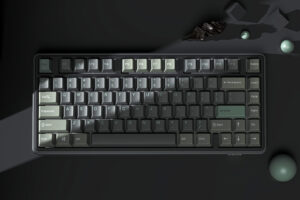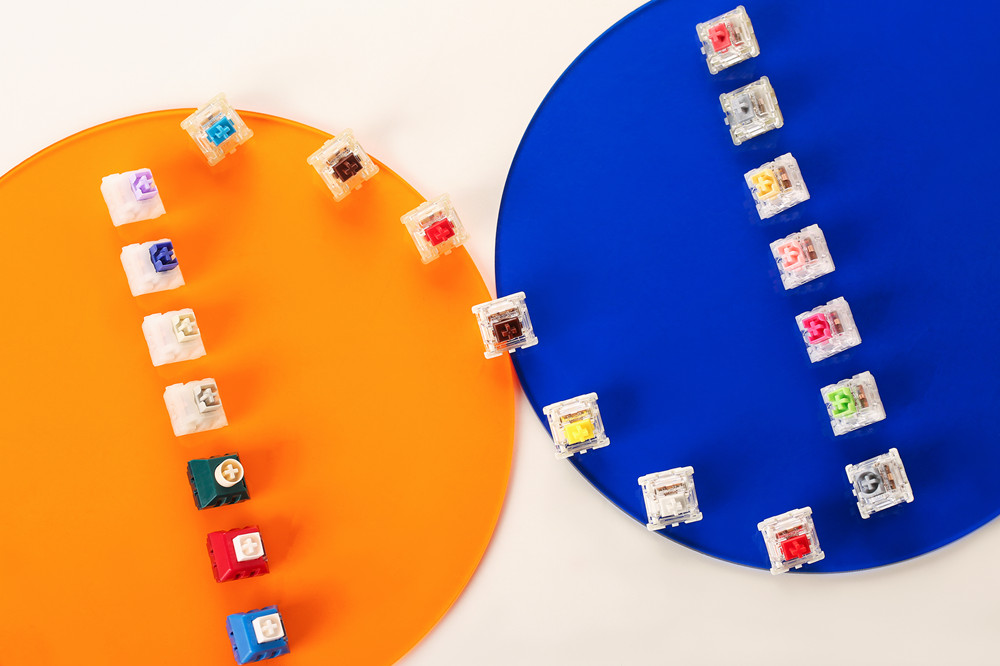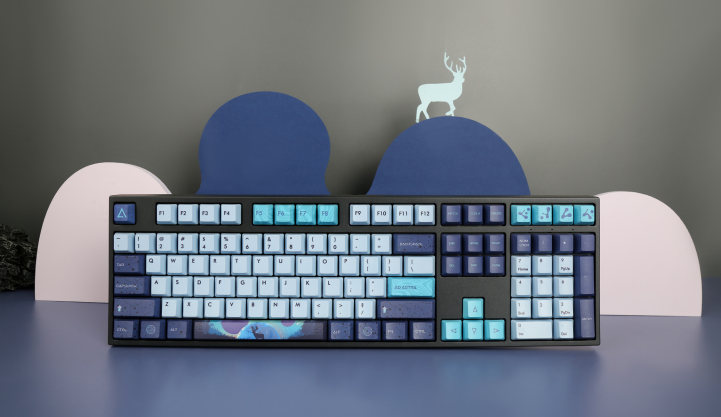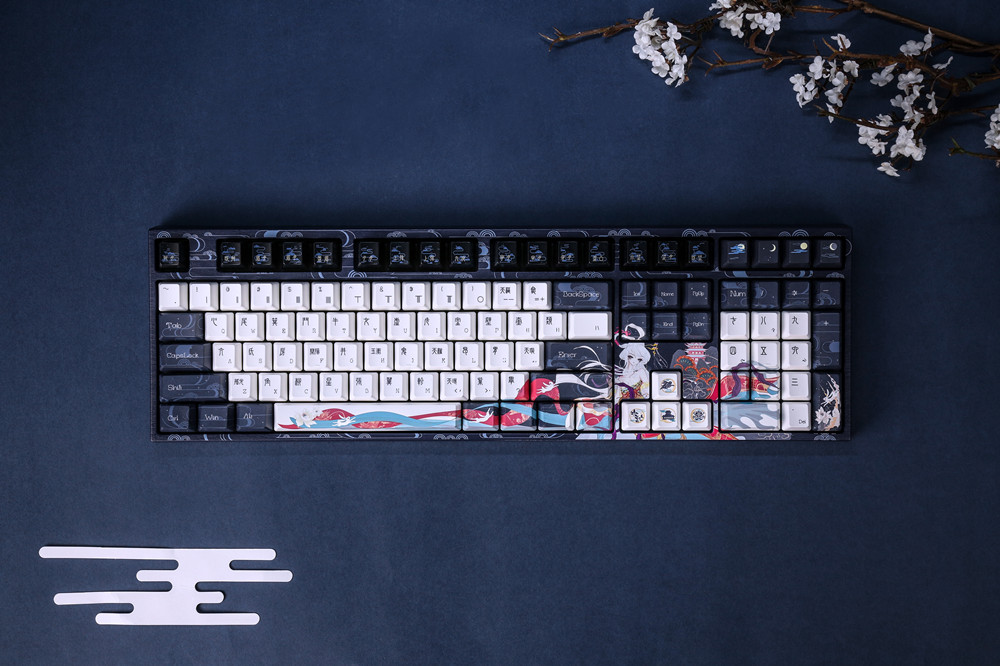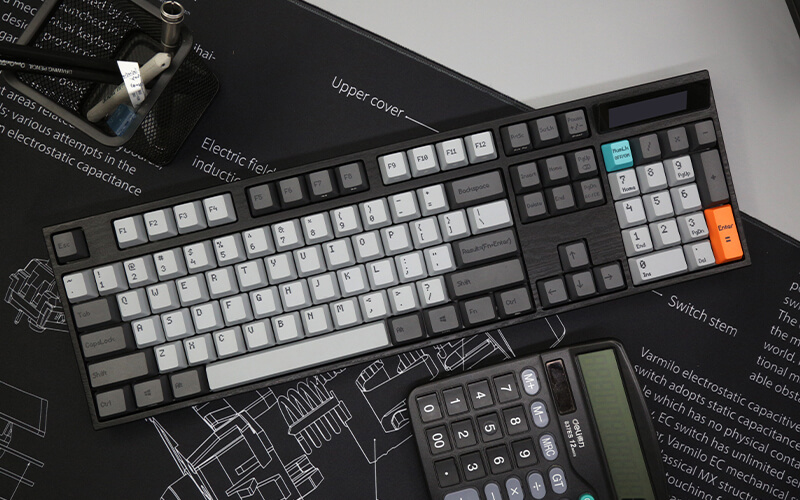Carp has been raised and cultured by human beings since ancient times. It is one of the earliest fish species cultured by human beings and plays an essential role in human civilization. As a special member of the carp family, Koi is well known for its colorful skin and elegant shape and gains great popularity among people worldwide. In 2019, inspired by the koi’s image and the characters from a comic series named Hua Culture Girls, Varmilo designed and released a new series of mechanical keyboards called Varmilo Koi.

You might be no stranger to koi, but how much do you know about the koi’s origin and development and what they are symbolic of in the Chinese and Japanese cultures, respectively? Today we will talk about the origin and development of koi culture in human history.
The origin of Koi
Common carp and koi carp origin from the same ancestor and evolve into two different species. Before learning about koi, we need to get to know common carp in the first place.

Dating back to the Chinese Yin Shang dynasty in 12 B.C., ancient Chinese ancestors had begun to culture carp fishes. According to a poetry anthology Shi Jing from ancient China, the King Wen of Zhou dynasty had ever raised carps in fish ponds, which was 3000 years ago. Another story about carps happened at the end of the Spring and Autumn period in Chinese history. In showing his mercy and appreciation to the famous philosopher Confucius, the then ruler of the state of Lu (Lu Zhaogong) gave a big carp fish to Confucius as a present in the celebration of the birth of Confucius’s son. This special present conveyed the King’s best wishes for health, bravery, good luck, and happiness in growth. Taking it as a great honor, Confucius decided to name his newborn son Li (means carp in Chinese). It is the first time carp was given a symbolic meaning. After that, this symbolic meaning was widely accepted and inherited later in the Chinese culture.

However, things changed dramatically in the carp fish industry coming to Tang Dynasty. As the Chinese name for carp sounds the same as the then ruler’s name Li, the empire imposed a ban on selling and eating carp fishes. As a result, the carp fishes lost their industry value soon, and the carp fish culture slowly faded from then on in China. Luckily, thanks to the cultural transmission, a famous ancient Chinese legend “Carp leaping over the dragon gate” was introduced to and gained tremendous popularity across the neighboring country Japan, which help carp fish culture be inherited and blossomed in this country later.

“Carp leaping over the dragon gate” was a legendary Chinese story about a group of carp fishes living in front of a dragon gate. If a carp successfully leaps over the dragon gate, it would turn into a dragon. Otherwise, it remains to be an ordinary fish. Only those skillful enough carp can finish the leap. Over time, people use this story as a metaphor for achieving great success in one’s career or striving to make progress in specific areas. Over an extended period, paintings and images based on the story of “Carp leaping over the dragon gate” have been widely kept and used by the Chinese people as a symbol of good fortune.
The development of Koi culture
The Japanese people treat the koi as an artistic fish and call them the fish of luck, the fish of fortune, the living treasures under the water, and the king of ornamental fishes. In Japanese culture, on the one hand, koi is a symbol of strength with its solid body showing strong power; on the other hand, it is also a symbol of happiness and health, and it is widely accepted and loved by the Japanese people.

It is said that, during the Three Kingdoms Period of China, carp fish was first introduced into Japan by immigrants and settled down in this country since then. As the story of “Carp leaping over the dragon gate” was introduced and widely spread across Japanese society, the Japanese people start to take the koi fish as a symbol of good luck. In praying for good luck for their kids, on May 5th in the solar calendar every year (also known as the Boy’s Day in Japan), each family will hang up some carp fish flags, hoping their gods would notice and bring happiness and health to their kids. It is also a memorial event to express gratitude to all the mothers for giving birth to their children, and it has become a festival tradition for a long time.

Carp fish turning into koi was actually an accident joke made by the nature. One day, a fish-man from Niigata-ken found some carp fishes experience mutations in their biological features as some skins in the belly and the back of the fish bodies turned colorful. This abnormal change caused a sensation in the industry. Soon, the smart fish-men started to cultivate and improve the mutated carps and created a new species named Koi ever since.

With the symbolic meaning of good fortune and happiness, the carp fish became even more popular among the upper class after turning into Koi. Raising koi fishes became a fashionable entertainment among the upper class. The Japanese imperial family also kept up with the latest trend and raised koi in the palace. After that, koi was formally recognized as the “national fish” of Japan.

In Japanese culture, you can find the elements of koi in many places. For example, in the Pocket Monsters, the character of Magikarp is designed from koi fish. Though its fighting capacity is weak before evolution, it has always acted as a magic monster with tenacious vitality, just like a carp fish swimming against the stream.
Varmilo Koi mechanical keyboard
Though the koi’s culture bloomed in Japan, the Varmilo Koi mechanical keyboard takes the symbolic meaning of koi under Chinese culture while applying some Japanese artistic creation techniques.

We choose Chinese red for the color of the keyboard, which carries the same symbolic meanings as the koi fish and represents the best wishes from Chinese people for a lucky and happy life. Varmilo Koi is designed with a dominant color of cinnabar red, supplemented with pearl white for its alphanumeric keys, showing a typical Chinese style design.

“Water” is also an essential element in Chinese culture that represents prosperity. The combination of fish and water elements often implies endless fortunes and happiness, reflecting Chinese people’s hope for a better life. For the outer case of the keyboard, Varmilo applies some wave images echoing the theme of koi. An interacting design of fish and water helps the keyboard naturally reflect the koi theme, making it an elegant product.


We redesigned the fonts of all the characters showing on the Varmilo Koi keyboard. The brand new specially designed fonts perfectly reflect the keyboard’s theme, creating a consistent and artistic overall look for the keyboard. Many small innovative designs are being applied in the keyboard. For examples, we use a fountain image as the design for the character T, and replace the S in Shift key with little fishes, etc. The users may get different surprises in every click.


In designing the letter keys, Varmilo seeks ideas from “water” and applies water drop and water splash images in the letters’ font designs. The Enter key is designed in a famous Japanese art style UKiyoe, while the ESC key is covered with a lotus flower image. Putting them together, we see a living picture described by an old Chinese saying “Lotus blooms out of the water”. Using such a keyboard, you can imagine the water flowing under your fingertips.

The space bar is covered with a delicate drawing of koi fishes playing among lotus flowers. Every snapping back of the space bar brings you a beautiful scenery view as if you are in front of a lotus pond, which provides a fantastic typing experience.

The directional keys tell the story of “Carp leaping over the dragon gate”. Three keys in the lower line form an image of splashed water while a carp fish leaps over on the upper key. The design has an implied meaning of swimming against the upstream, inspiring people to keep fighting and moving forward. The adorable koi fish girl painted above them also adds a sense of energy and spirituality to the keyboard.

The four multi-media buttons in the keyboard’s right-hand corner also get their new looks with some ancient Chinese elements added on their surfaces. We use the classic old Chinese instrument Pipa for the music button, the old Chinese communication tool kite for the mailbox button, the old Chinese calculating device abacus for the calculator button, and the ancient city gate for My Computer button. These ancient cultural elements add joy to our daily use.

For such an excellent keyboard, comparably good packaging is necessary. The package of Varmilo Koi mechanical keyboard applies the same design as the keyboard itself, enclosed with four postcards as presents, namely the “Guose”, “Tianxiang”, “Biyue” and “Xiuhua” respectively, representing four stories of the Four Beauties in ancient China. We also design four mousepads under the same names as the above four postcards. Users can buy mouse pads independently.




Clearly, Varmilo has devoted a lot to designing the Varmilo Koi keyboard series. The product details and cultural concepts perfectly emerged into the product, making it an excellent keyboard product in both cultural and artistic aspects. Of course, a good keyboard can never be made without modern technologies, and the Varmilo Koi is no exception.
UV printing is applied to the keyboard’s outer case, creating rich and long-lasting colors for the products. 5 sides dye-sublimation process is applied to the keycaps production. There is no color difference visible to the naked eyes between two keycaps in the same color, and the color uniformity control for the keycaps is good. Besides, as one of the traditional competitive edges of Varmilo, the keycaps are made of wear-resisting material, which provides consistent typing feelings over long-term usage.
Furthermore, users can choose from four types of Cherry switches, namely the MX Black, MX Blue, MX Brown, and MX Red with a layout of 87 or 108 keys. Later, we will add our Varmilo EC switch into this product series as a supplement to meet most players’ needs.
In conclusion, the Varmilo Koi mechanical keyboard is a piece of delicate artwork. Varmilo seeks design ideas from daily life and puts them into its products smartly so that the users can easily feel the implied cultural meanings in using such a keyboard. Excellency comes from Varmilo’s continual dedication, and it is also the core value pursued by Varmilo in the keyboard industry. Such an outstanding “artistic keyboard” will surely be widely accepted by the users from the markets.
